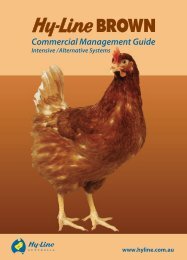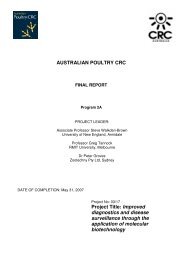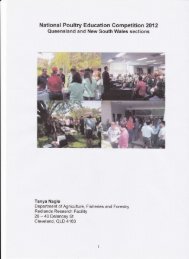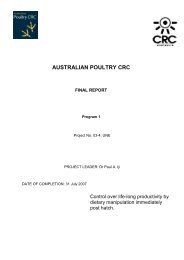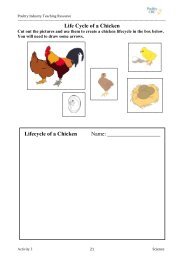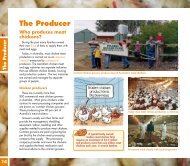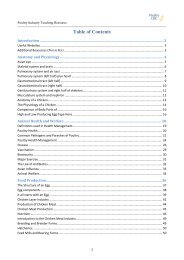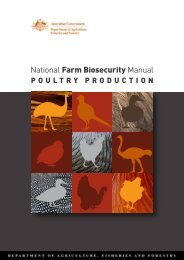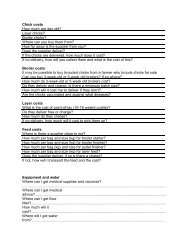AUSTRALIAN POULTRY CRC - Poultry Hub
AUSTRALIAN POULTRY CRC - Poultry Hub
AUSTRALIAN POULTRY CRC - Poultry Hub
- No tags were found...
You also want an ePaper? Increase the reach of your titles
YUMPU automatically turns print PDFs into web optimized ePapers that Google loves.
HensTable 3 shows the predominant breed/strain of birds that are used in the farms surveyed with all farmsexcept one having hens of a single age in each shed.Table 3: Predominant breed/strain of bird used in the free range farms surveyed.Breed/strainLocationHyline Bond HiSexCommercial BondIsa BrownBrown Brown BrownX B‟s BlackQueensland 2 3 1 1New South Wales 1Victoria 2 2 2South Australia 1 1 1 1TOTAL 5 3 4 4 1 1Fifty percent of farms reared their own birds on farm. Regardless of whether birds were reared on oroff farm only one farm had birds reared on wire, with all other birds reared on the floor. Of the farmsthat reared off farm, 72% bought in replacement pullets at 13 – 16 weeks of age with the remainingtwo farms buying their pullets in at 5 – 8 weeks old and greater than 17 weeks, respectively. Table 4shows at what age pullets started ranging.Table 4: Age pullets start ranging.Age pullets start rangingLocation13 – 181 – 3 weeks 4 – 6 weeks 7 – 12 weeksweeks>18 weeksQueensland 1 3 1New South Wales 1Victoria 1 1 1 1South Australia 1 1 2TOTAL 2 4 2 2 4Hens were disposed of at ages ranging from 55 weeks to greater than 95 weeks, with 64% of producersdisposing of hens when they were 76 – 85 weeks of age. Eight out of the fourteen producers replacedhens on an all in all out basis. Eight producers also used a 16:8 hour lighting regime. The average rateof production ranged from 60 – 65 % to greater than 85%, 72% of producers averaging between 66and 85%. Floor eggs were not considered a problem with all producers reporting less than 2%.ManagementAll producers reported that their hens were allowed to range in all daylight hours with all but oneallowing hens to range regardless of weather conditions. Three producers beak trimmed their birds asa matter of routine. All producers undertook a regular rodent baiting programme with 50% baitingonly as required. One producer did not undertake regular worming of their birds, with 54% ofproducers who undertook worming did so tri-monthly and the remaining producers worming asrequired. Eight of the 14 producers regularly treated their birds for external parasites, with 75% on anas required basis. Table 5 shows what measures are taken in between flocks of hens in a particularshed.12



